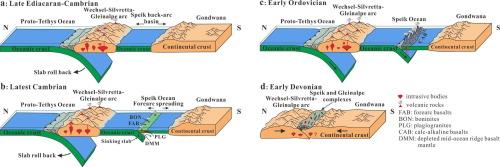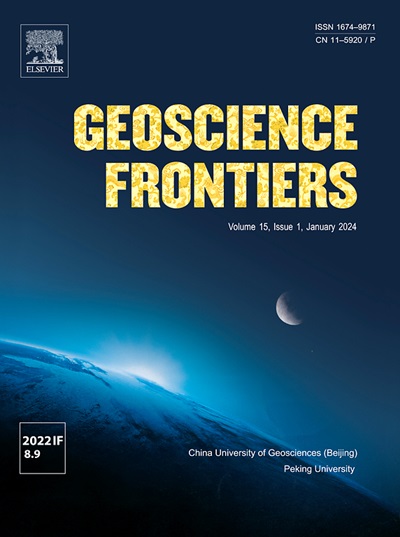Early Paleozoic subduction initiation in the West Proto-Tethys Ocean: Insights from ophiolitic Speik Complex in the Eastern Alps
IF 8.9
1区 地球科学
Q1 GEOSCIENCES, MULTIDISCIPLINARY
引用次数: 0
Abstract
Subduction initiation is a critical part of the plate tectonic system, but its geodynamic process is still poorly understood due to the lack of well-preserved geological records. Based on new zircon U–Pb–Hf isotopic and whole-rock geochemical data, we report the first discovery of a latest Cambrian–Early Ordovician forearc-arc rock sequence in the Eastern Alps. This sequence includes granitic gneisses, amphibolites, and amphibole plagiogneisses from the ophiolitic Speik Complex and Gleinalpe Complex. These rocks exhibit geochemical affinities with typical oceanic plagiogranites, forearc basalts (FABs), and island arc basalts, respectively. The latest Cambrian plagiogranitic protoliths (491 ± 2 Ma) are shearing-type plagiogranites that were formed in the tectonic setting of forearc spreading. The latest Cambrian FABs (496–489 Ma) have similar geochemical compositions and positive εHf(t) values (+2.5 to + 14.9) to the depleted mid-ocean ridge basalts. However, they show depletion in high field strength elements (HFSEs; e.g., Nb, Ta, and Zr) and have relatively low Ti/V ratios. These features suggest that they were derived from a depleted mantle source modified by subducting slab-released components in a forearc environment. The Early Ordovician basaltic protoliths (476–472 Ma) of amphibole plagiogneisses show enrichment in large ion lithophile elements and depletion in HFSEs (e.g. Nb, Ta, Zr, and Hf), implying a mature island arc environment. These metaigneous rocks, along with the coeval boninite-like high-Mg amphibolites near the study area, form a typical rock sequence resembling that of the Izu–Bonin–Mariana (IBM) arc system. The Speik and Gleinalpe complexes document a complete magmatic evolution from subduction initiation to mature arc development within the West Proto-Tethys Ocean. Integrating our new data with published work, we reconstruct the late Ediacaran–early Paleozoic tectonic evolution of the northern Gondwana. During the late Ediacaran–early Cambrian, the rollback of the West Proto-Tethys oceanic plate triggered the separation of the Wechsel-Silvretta-Gleinalpe continental arc from the northern Gondwana. This process led to the formation of the Speik back-arc oceanic basin, a southwestern branch of the West Proto-Tethys Ocean. In the latest Cambrian–Early Ordovician, subduction initiation occurred in the Speik Ocean, which subsequently developed into an intra-oceanic arc system. During the Early Devonian, the Speik Ocean closed and the Wechsel-Silvretta-Gleinalpe continental arc reattached to the Gondwana, as evidenced by the metamorphic event at ca. 400 Ma.

西原特提斯洋早古生代俯冲起始:来自东阿尔卑斯蛇绿岩Speik杂岩的启示
俯冲起裂是板块构造系统的一个重要组成部分,但由于缺乏保存完好的地质记录,人们对其地球动力学过程仍知之甚少。根据新的锆石U-Pb-Hf同位素和全岩地球化学资料,在东阿尔卑斯首次发现了最新的寒武系—早奥陶世前弧-弧岩层序。该序列包括来自蛇绿岩Speik杂岩和Gleinalpe杂岩的花岗质片麻岩、角闪岩和角闪孔斜长岩。这些岩石分别与典型的海洋斜长花岗岩、弧前玄武岩和岛弧玄武岩具有地球化学相似性。最新的寒武系斜长花岗岩原岩(491±2 Ma)是在弧前扩张构造背景下形成的剪切型斜长花岗岩。最新寒武系FABs (496 ~ 489 Ma)的地球化学组成和正εHf(t)值(+2.5 ~ + 14.9)与洋中脊贫化玄武岩相似。然而,它们在高场强元素(hfse)中表现出耗竭;例如,Nb, Ta和Zr),并且具有相对较低的Ti/V比率。这些特征表明,它们是由弧前环境中俯冲的板块释放成分改造而成的衰竭地幔源形成的。早奥陶世角闪斜岩玄武岩原岩(476 ~ 472 Ma)表现出大离子亲石元素富集、高铁元素(Nb、Ta、Zr、Hf)缺失的特征,表明其发育成熟的岛弧环境。这些变质岩与研究区附近同时期的类博宁-高镁角闪岩一起,形成了一个典型的类似伊豆-博宁-马里亚纳弧系的岩石层序。Speik和Gleinalpe杂岩记录了西原特提斯洋从俯冲起始到成熟弧发育的完整岩浆演化过程。结合已发表的研究成果,我们重建了冈瓦纳北部晚埃迪卡拉-早古生代的构造演化。在埃迪卡拉晚期-寒武纪早期,西原特提斯大洋板块的回退引发了Wechsel-Silvretta-Gleinalpe大陆弧与冈瓦纳大陆北部的分离。这一过程导致了斯比克弧后洋盆地的形成,这是西原特提斯洋的西南分支。晚寒武世—早奥陶世,Speik洋开始俯冲,随后发展为洋内弧体系。早泥盆世,Speik洋闭合,Wechsel-Silvretta-Gleinalpe大陆弧与Gondwana大陆弧重新连接,约400 Ma的变质事件证明了这一点。
本文章由计算机程序翻译,如有差异,请以英文原文为准。
求助全文
约1分钟内获得全文
求助全文
来源期刊

Geoscience frontiers
Earth and Planetary Sciences-General Earth and Planetary Sciences
CiteScore
17.80
自引率
3.40%
发文量
147
审稿时长
35 days
期刊介绍:
Geoscience Frontiers (GSF) is the Journal of China University of Geosciences (Beijing) and Peking University. It publishes peer-reviewed research articles and reviews in interdisciplinary fields of Earth and Planetary Sciences. GSF covers various research areas including petrology and geochemistry, lithospheric architecture and mantle dynamics, global tectonics, economic geology and fuel exploration, geophysics, stratigraphy and paleontology, environmental and engineering geology, astrogeology, and the nexus of resources-energy-emissions-climate under Sustainable Development Goals. The journal aims to bridge innovative, provocative, and challenging concepts and models in these fields, providing insights on correlations and evolution.
 求助内容:
求助内容: 应助结果提醒方式:
应助结果提醒方式:


